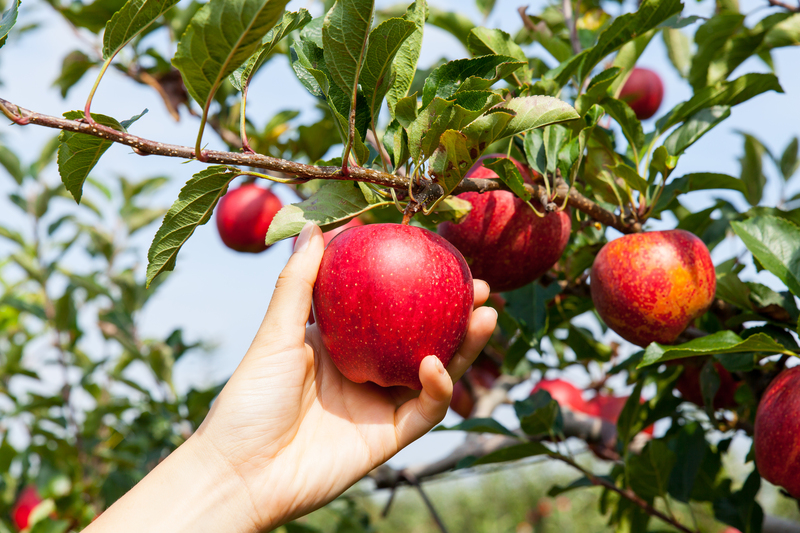Your Guide to Thriving Orchids
Posted on 22/08/2025
Your Guide to Thriving Orchids
Orchids are among the most captivating and diverse flowers in the plant kingdom. Their exotic beauty, vast variety, and unique growth habits fascinate both novice and experienced gardeners alike. Yet, many houseplant enthusiasts shy away from growing orchids due to their reputation for delicate care. The truth is, with the right knowledge and techniques, anyone can cultivate vibrant, healthy, and flourishing orchids at home. This comprehensive guide will walk you through everything you need to know about thriving orchids--from understanding their unique needs to ensuring strong, spectacular blooms year after year.

Understanding Orchid Basics
What Makes Orchids Unique?
Orchids (family Orchidaceae) represent one of the largest and oldest plant families, boasting over 25,000 species and more than 100,000 hybrids. Their structural uniqueness and adaptability allow them to grow in diverse habitats around the world, from tropical rainforests to arid deserts. Orchids differ from most houseplants in several key ways:
- Epiphytic Nature--Many orchids grow on trees, absorbing moisture and nutrients from the air, rain, and decaying plant matter.
- Root Structure--Most varieties possess thick, spongy aerial roots that require excellent air circulation.
- Diverse Blooms--Orchid flowers boast intricate shapes and striking colors, attracting specific pollinators in the wild.
Popular Types of Orchids for Beginners
Not all orchids are equally suited for indoor gardening. Here are the most beginner-friendly types that thrive indoors:
- Phalaenopsis (Moth Orchid): Known for long-lasting blooms and ease of care, these are the most popular houseplant orchids.
- Cattleya: Famous for their showy, fragrant flowers. They require a bit more light than Phalaenopsis but adapt well to indoor conditions.
- Dendrobium: Valued for their tall canes and clusters of blossoms. They come in a wide variety of sizes and colors.
- Oncidium (Dancing Lady): Loved for their airy sprays of small, vibrant flowers.
- Paphiopedilum (Lady Slipper): These terrestrial orchids are praised for their pouch-shaped blooms and broader leaves.
Key Factors for Thriving Orchid Care
Light: The Foundation of Healthy Orchids
One of the most critical factors in orchid success is providing the right amount of light. Orchids generally prefer bright, indirect sunlight. Too little light will stunt growth and prevent blooming, while too much can scorch leaves. Here's how to find the sweet spot:
- Phalaenopsis: Medium to low filtered light. East-facing windows are ideal.
- Cattleya & Oncidium: Require more light--south or west-facing window with a sheer curtain works best.
- Paphiopedilum: Prefer moderate, indirect light, like that of a north or east window.
Tip: If your orchid's leaves are dark green, it may need more light; yellowish leaves may indicate too much light.
Optimal Watering Techniques
Improper watering is the number one reason orchids fail to thrive. Most orchids need to dry out slightly between waterings. Here are the basic principles:
- Water thoroughly, allowing water to drain completely through the pot's holes.
- Avoid letting orchids sit in water, which can cause root rot.
- Water frequency depends on temperature, humidity, and potting media. In general, water every 5-10 days.
- Use room-temperature, non-softened water. Rainwater or distilled water is often best.
Signs of overwatering: Mushy, brown roots and yellowing leaves.
Signs of underwatering: Dry, wrinkled leaves and shriveled roots.
Humidity Needs for Orchids
Orchids flourish in environments with 40-70% humidity. Indoor air, especially in winter, can be very dry for orchids. Boost humidity with these methods:
- Place orchid pots on trays filled with pebbles and water (ensure pots aren't sitting directly in water).
- Use a room humidifier.
- Group plants together to increase local humidity.
- Mist orchids gently in the morning.
Insufficient humidity causes limp, wrinkled leaves and stalled growth.
Temperature Preferences
Most common orchid varieties prefer daytime temperatures between 65-80?F (18-27?C) and nighttime temperatures of 60-70?F (16-21?C). Many orchids, such as Phalaenopsis, benefit from a slight drop in temperature at night to help cue blooming.
Proper Orchid Potting & Repotting
Orchids require specific potting media and periodic repotting to thrive. Here's what you need to know:
- Use a well-draining, airy medium--such as bark, sphagnum moss, or coconut husk chips.
- Repot every 1-3 years, or when media breaks down and no longer drains well.
- Choose pots with drainage holes. Clear pots are useful for monitoring root health.
- Gently remove old media, trim dead roots, and set in fresh medium during repotting.
Feeding and Fertilizing Your Orchids
Choosing and Applying Orchid Fertilizer
Fertilize orchids lightly and regularly for luxurious blooms and strong growth. Use a balanced, water-soluble orchid fertilizer (such as 20-20-20) or one specifically formulated for orchids. Follow these basic guidelines:
- Feed once every two weeks while actively growing (spring and summer).
- Reduce fertilizing to once per month during fall and winter.
- Flush the pot with plain water monthly to prevent salt buildup.
- Use a weak solution (about 1/4 to 1/2 of the recommended strength).
Remember: It's better to under-fertilize than over-fertilize orchids. Excess nutrients can scorch roots and inhibit blooming.
Troubleshooting Common Orchid Problems
Orchid Pests and Diseases
Like all houseplants, thriving orchids may encounter pests and diseases. Early detection and proper treatment are key to maintaining health:
- Mealybugs: White, cottony masses on leaves. Remove with rubbing alcohol-soaked cotton swabs.
- Scale: Brown, shell-like bumps. Scrub gently with a soft brush and treat with insecticidal soap.
- Aphids and spider mites: Rinse plant thoroughly and increase humidity.
- Root rot or fungal infections: Trim damaged roots, apply a fungicide, and repot using fresh medium.
Good orchid hygiene is preventive care. Always use clean tools, remove dead leaves, and isolate new plants before adding to your collection.
Why Isn't My Orchid Blooming?
This is a common problem for orchid growers. Here are the usual culprits and solutions:
- Insufficient light: Move the plant to a brighter location, being careful not to scorch it.
- Improper temperature drops: Some orchids require cool nights and a change in temperature to trigger flowering.
- Old or depleted potting medium: Repot your orchid if the medium is disintegrating or smells sour.
- Under or over-fertilizing: Adjust your feeding regimen for optimal health and encourages vibrant blooms.
- Seasonal changes: Some orchids require a dormant period before reblooming.
Patience is crucial--orchids sometimes take months to respond to improved care.
Advanced Orchid Care Tips
Encouraging Re-blooming
Many orchid growers want to know the secrets to getting those spectacular flowers to return year after year. Here are a few advanced tips:
- Provide 12-16 hours of light daily during the growing season using supplemental grow lights if needed.
- Ensure nighttime temperatures are 10-15?F cooler than daytime for certain orchids, like Phalaenopsis.
- Maintain steady humidity and consistent watering, especially after blooming as a plant resets for a new growth cycle.
- Trim finished flower spikes properly--some orchids rebloom from existing spikes, others should have them cut off when flowers fade.
Propagation and Division
Once you get the hang of thriving orchids, you might want to multiply your collection. Most commonly, orchids are propagated via division during repotting:
- Choose a plant with multiple healthy growths or pseudobulbs.
- Gently separate sections, each with at least three healthy bulbs and roots.
- Repot in fresh media and care for as usual.
Some types, like Phalaenopsis, can produce "keikis"--small baby orchids--that can be gently removed and planted independently.
Best Practices For Year-Round Thriving Orchids
- Research your orchid--each species has its quirks and preferences.
- Monitor roots--healthy orchid roots are plump and silvery-green.
- Stay consistent--orchids adapt poorly to sudden changes in environment or schedule.
- Maintain an orchid care journal to track watering, feeding, and bloom cycles.
- Invest in specialized orchid media and containers for optimal results.

Decorating With Thriving Orchids
Revitalize your home with the unmatched elegance of orchids. Place them as focal points in living rooms, bathrooms with filtered light, or grouped together as an indoor orchid garden. Their sculptural form and dazzling flowers add luxury and tranquility to any interior. Choose decorative, yet functional, orchid pots to complement your decor and showcase your thriving orchid collection.
Conclusion: Your Path to Spectacular, Thriving Orchids
With this complete guide, nurturing healthy orchids becomes an enriching journey rather than a daunting challenge. Remember: the keys to thriving orchids are light, proper watering, humidity, temperature, quality potting medium, and regular, light feeding. Practice patience, observe your plants, and you'll be rewarded with mesmerizing blooms and lush, leafy growth. Whether you're brand new to orchid care or looking to grow your indoor garden, let your adventure into orchids bring lasting beauty and fulfillment to your space.
Start your orchid-growing journey today--your home (and your senses) will thank you!

